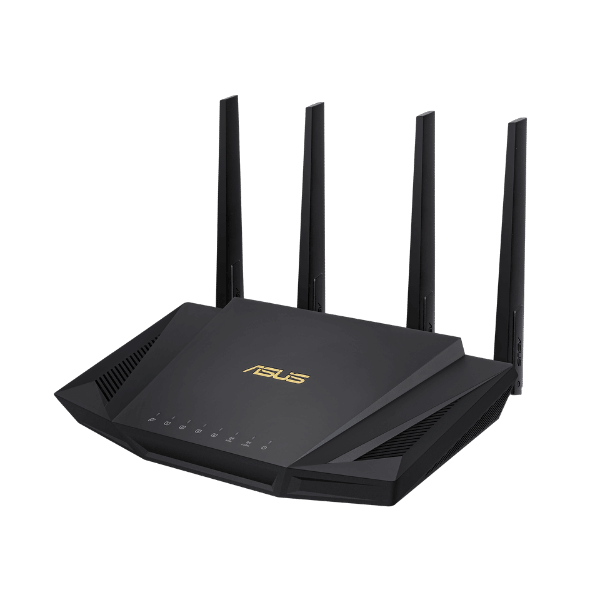This is our review of the best routers for Mediacom in 2024

Mediacom is an internet service provider exclusively offering cable internet. However, their plans range from 60 Mbps all the way up to 1000 Mbps.
Because of this, what router is best for you will really depend on what plan you have.
But we can confidently say the ASUS RT-AX3000 is the best offering between speed, price, and features for any Mediacom plan.
Editor’s Choice – ASUS RT-AX3000
Best Overall
- Type: Wi-Fi Router
- Tested Max Speed: 889.41 Mbps
- Wireless Standard: Wi-Fi 6
- Recommended for: Any Mediacom internet plan
- Warranty: 2 years
We didn’t stop there. We tested dozens of routers ourselves in real-world scenarios to see which performs best for Mediacom.
Let’s look at some different options based on your Mediacom plan and budget.
Top 7 Routers For Mediacom
- ASUS RT-AX3000 (Editors Choice – Wi-Fi 6 Router)
- TP-Link Archer AX10 (Budget-Friendly – Wi-Fi 5 Router)
- ASUS RT-AX88U (Best for Gigabit – Wi-Fi 6 Router)
- Netgear RAXE500 (Best Premium – Wi-Fi 6E Router)
- Netgear CAX80 (Best Modem/Router Combo – WiFi 5 Gateway)
- TP-Link Deca S4 (Best Budget-Friendly Mesh System – Mesh Wi-Fi)
- Netgear Orbi RBK852 (Premium Mesh System – Mesh Wi-Fi)
Best 7 Routers for Mediacom
Here are the best routers for Mediacom Cable internet. With both traditional routers and mesh Wi-Fi to choose from.
#1 Editor’s Choice (Best Overall) – ASUS RT-AX3000
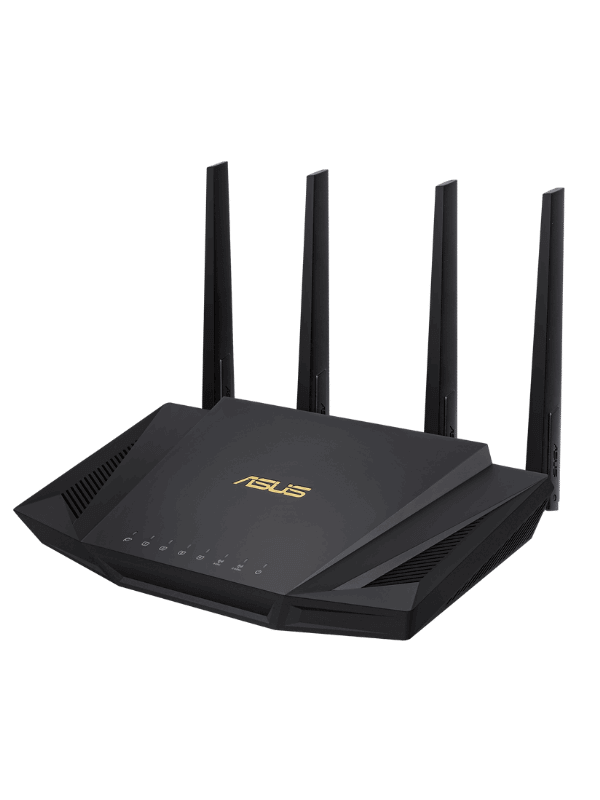
- Type: Wi-Fi Router
- Tested Max Speed: 889.41 Mbps
- Wireless Standard: Wi-Fi 6
- Recommended for: Any Mediacom internet plan
- Warranty: 2 years
Pros
- Good performance
- Free app and security features
- Compact design
Cons
- Mediocre range
- No multi-gig ports
The ASUS RT-AX3000 has repeatedly made it into many of our “Best for” lists. And for a good reason.
During our speed tests, it clocked 889.41 Mbps at 5 feet on the 5 GHz band. Farther away at 25 feet, range did seem to have an impact on performance. The ASUS was able to output 535.55 Mbps then.
But we were impressed that the RT-AX3000 could still achieve 415.11 Mbps even at 50 feet distance. So doubling the distance this time didn’t have the same negative effect.
The AX-3000’s range is pretty average, but not bad. We were able to go around 85 feet from the router before we lost its signal.
Considering its price, the value proposition for this router is out of this world for ALL Mediacom internet plans. That’s not something we’re frequently able to say.
The ASUS RT-AX3000 can handle the vast majority of any household’s internet needs. Whether it’s HD or 4K streaming, gaming, videoconferences, or heavy browsing, the RT-AX3000 breezes through it.
Let’s talk features.
We would classify this router as mid-range. And its features certainly back up that claim.
It has all features you would expect from a good router.
Parental controls are good, allowing you to monitor and customize the websites your children can visit. In addition, you can create schedules for each device which helps you control their screen time easily.
It also includes a Quality of Service feature (QoS) with adaptive QoS capabilities. This will help you prioritize important activities, like streaming or gaming, and ensure they always work as expected by reserving bandwidth for those before any other activity.
There are more traffic control features worth mentioning. Like bandwidth limitation, which helps you control how much data a device, app, or activity can consume.
Take good note of this feature; you’ll need it for Mediacom as all their plans have data caps. But more on that later.
In general, the ASUS RT-AX3000 is simply an amazing deal. Even if you have the fastest Mediacom plan (1000 Mbps), this router will not disappoint.
For more info, read our ASUS RT-AX3000 review.
#2 Budget-Friendly – TP-Link Archer AX10
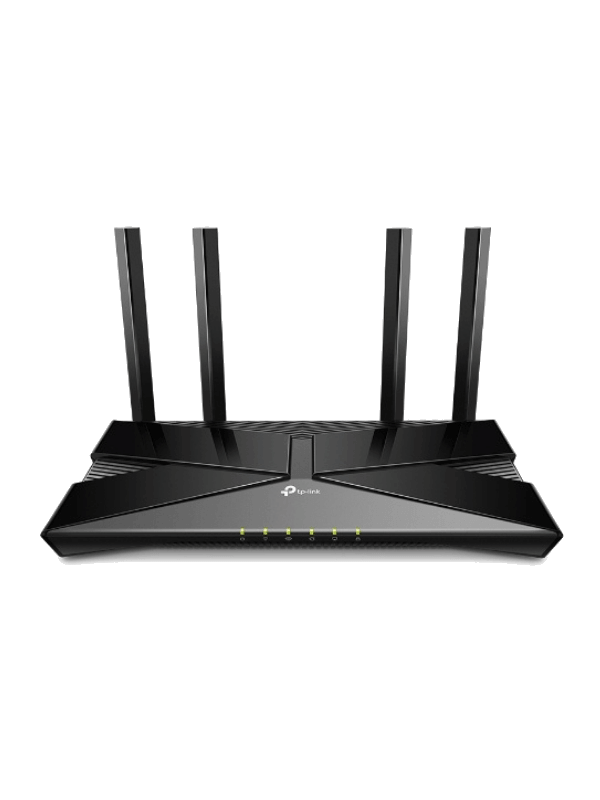
- Type: Wi-Fi Router
- Tested Max Speed: 651.97 Mbps
- Wireless Standard: Wi-Fi 6
- Recommended for: Internet 300 or below
- Warranty: 2 years
Pros
- Strong speed for the price
- Reasonable range
- Smart features
Cons
- No USB ports
If you happen to be on a tighter budget, the TP-Link Archer AX10 has got you covered.
While it is a basic, entry-level router, its performance might make you think otherwise. The Archer AX10 came in at 651.97 Mbps in the 5 GHz band at 5 feet distance during our tests.
We noticed distance is a big factor for the AX10. Twenty-five feet away from the router, performance dropped to 351.81 Mbps. Which, to be fair, is still amazing for the Mediacom Internet 300 plan or any other below it.
Range-wise, the AX10 does not disappoint for a budget router. We could still see its signal while being around 90 feet away. But anything more than that, and it’s gone.
You’re probably wondering why we are talking about premium speeds on a budget router. Good question.
As you might expect, some sacrifices needed to be made to achieve such a competitive price with performance like this. Mostly in the feature department.
Let’s take parental controls, for example. They’re present; there’s that. But extremely limited. URL filtering to block specific websites and time schedules to cut off the internet for certain devices at specific times is all you get.
Quality of Service (QoS) shares the same story. It’s there, but there’s no adaptive QoS, and it’s limited to device prioritization only.
It’s not all bad, though. The TP-Link Archer AX10 is compatible with TP-Link OneMesh™, so you can pair it up with other TP-Link routers and create a single, seamless network that covers much larger areas.
If your needs are basic or at least limited to good speeds, the Archer AX10 is almost a steal. There simply isn’t anything that compares at this price point. Especially for Mediacom plans of 300 Mbps or below.
For more info, read our TP-Link Archer AX10 review.
#3 Best for Gigabit – ASUS RT-AX88U
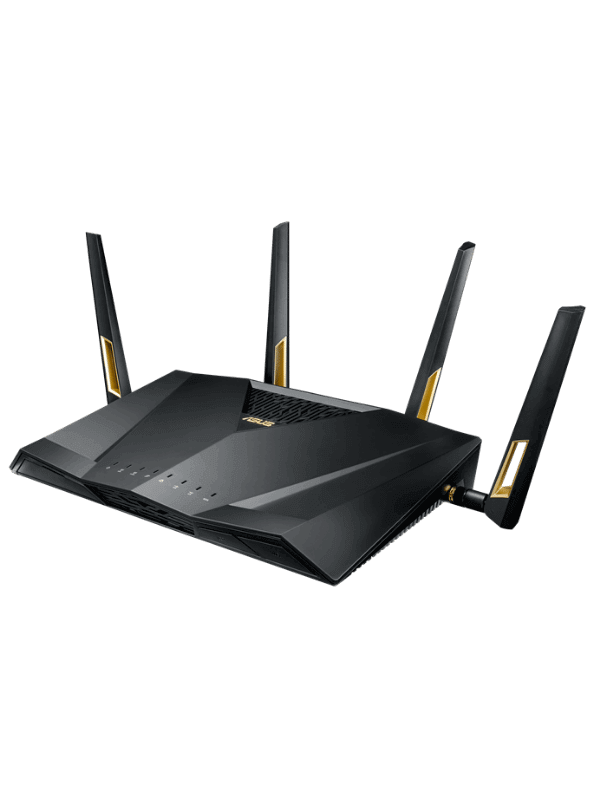
- Type: Wi-Fi Router
- Tested Max Speed: 927.17 Mbps
- Wireless Standard: Wi-Fi 6
- Recommended for: 1000 Mbps (Gigabit) plan
- Warranty: 2 years
Pros
- Very fast
- Remarkably good range
- Smart features
Cons
- Expensive
If you have Mediacom’s Gigabit Internet plan (1000 Mbps), things get a bit tricky.
The routers we’ve mentioned above are great options. But if you’re subscribed to the Gigabit plan, you’ll be wasting precious bandwidth with them.
Always remember that no matter how fast your internet connection is, it will always be limited by your router’s capabilities.
If you’d like to extract the most out of your Gigabit plan, the ASUS RT-AX88U is the way to go.
During our tests, we were able to get 927.17 Mbps download speeds at 5 feet distance on the 5 GHz band.
Stepping an additional 20 feet away, performance dropped to 571.36 Mbps, which is noticeable, but in line with our other tests. Even at 50 feet, we were still able to get 472.95 Mbps.
The RT-AX88U has a great range. We could see its signal being almost 110 feet away, which was pretty impressive.
So, even if you are somewhat far from the RT-AX88U, it will be capable of handling most network-intensive tasks with ease. 4K streaming, gaming, hi-res video calls, you name it—the RT-AX88U can handle it.
Now, all of this performance comes at a price. The RT-AX88U is no budget router. However, it’s not extremely expensive either. And taking into account all the features it includes, we’d say it is well worth it.
Quality of Service (QoS) is top-notch, and includes adaptive QoS. This feature will help you ensure your critical activities always work as intended by reserving bandwidth for them.
For example, if gaming is your priority, adaptive QoS will ensure your games get all the bandwidth they need before sharing any with other activities.
The RT-AX88U offers a full set of parental controls. Allowing you to control the browsing activity of your children. With this feature, you can block specific websites or applications and set schedules for their internet usage.
Another interesting feature is ASUS AiProtection Pro™ powered by Trend Micro, which helps you ramp up the security of your network without any complex settings. It regularly updates your security signatures and protects your data from online threats.
The AX88U’s antennas might seem intimidating, but they serve a good purpose. Leveraging MU-MIMO and OFDMA, the router will be able to communicate with several devices simultaneously and point its signal directly in their direction. This results in better overall performance for your devices.
As you can see, the ASUS RT-AX88U can justify its price.
But if you were looking for the best of the best, you are in for a treat with our next option.
For more info, read our ASUS RT-AX88U review.
#4 Best Premium Option – NETGEAR RAXE500
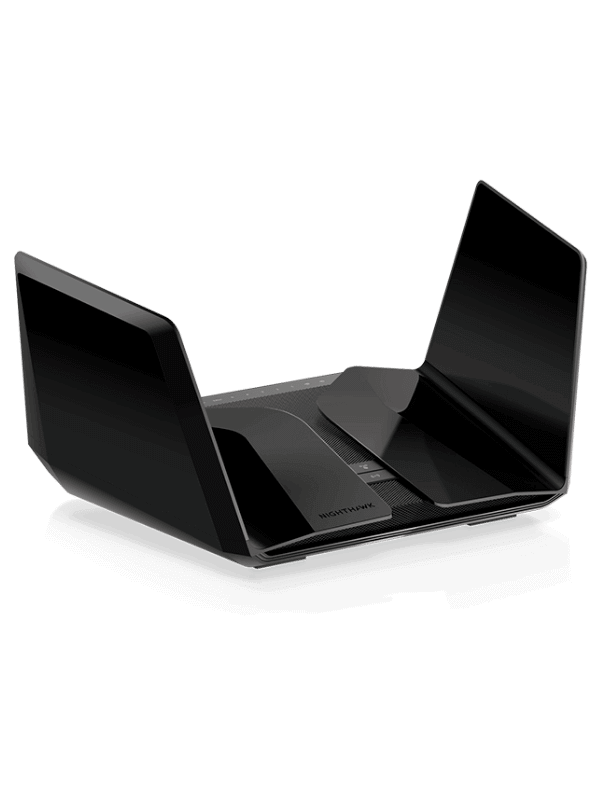
- Type: Wi-Fi Router
- Tested Max Speed: 1203.59 Mbps
- Wireless Standard: Wi-Fi 6E
- Recommended for: 1000 Mbps (Gigabit) plan
- Warranty: 1 year
Pros
- Very fast
- Good range
- Tri-band for more bandwidth
Cons
- Expensive
- Lacking features
The option above is a great router for a fair price, which will take advantage of almost all of your Gigabit bandwidth.
But if you are one of those users that won’t settle but anything but the absolute best performance, you’ll still be losing around 8% bandwidth with it.
Cue the NETGEAR RAXE500. A top-of-the-line premium router with a price tag that certainly reflects it.
Before getting into its details, note that the RAXE500 is a Wi-Fi 6E router. And to achieve its max speed, you’ll need to use the 6 GHz band. Meaning your client devices need to be compatible with such frequencies. Something not still not too common.
If they are, though, you’ll see some amazing performance.
The RAXE500 was able to output an impressive 1203.59 Mbps during our tests at 5 feet distance on the 6 GHz band. Even 25 feet away from the router, we could still get 959.71 Mbps.
If we go back to the 5 GHz band, though, the RAXE500’s max speed was around 770.94 Mbps. So, if your devices are not compatible with the 6 GHz band, you might be better off with our last option.
Talking strictly about distance, we could place ourselves beyond 100 feet, almost 110 to be exact, and still see its signal.
A second important thing to note about the RAXE500 is that the sole purpose of its existence is high performance. In this case, the price tag does not match the features.
Parental controls are barely there, limited to blocking websites and creating schedules only. Something to consider if you have children.
Quality of Service (QoS) is not included in any shape or form. Though you likely won’t need it with such high performance.
However, you can expect the bare minimum features such as guest networks to be present.
The RAXE500 was unapologetically created solely for performance and speed. If that’s what you’re looking for, that’s exactly what you’ll get with this router.
#5 Best Modem/Router Combo – NETGEAR CAX80
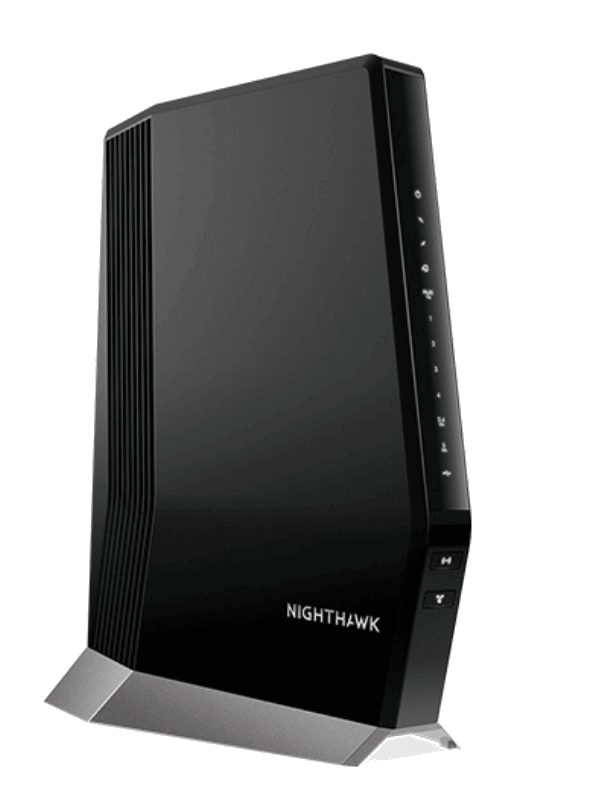
- Type: Modem/Router Combo
- Tested Max Speed: 800+ Mbps
- Wireless Standard: Wi-Fi 6
- Recommended for: All Mediacom plans
- Warranty: 1 year
Pros
- Very fast
- Future-proof
- Great range
Cons
- Expensive
- Lack features
Because Mediacom is a cable internet service provider, you’ll need a modem. And if you want wireless internet, you’ll need a separate router in order to have Wi-Fi.
There are devices, known as gateways, that are both modems and wireless routers. This helps save some space and, in most cases, some money.
In this case, the Netgear CAX80 combines a DOCSIS 3.1 modem and a Wi-Fi 6 dual-band router.
The Netgear CAX80 achieved over 800 Mbps during our tests at 5 feet distance on the 5 GHz band. Making it a great candidate for all but the fastest Mediacom plans.
Farther away, at 25 and 50 feet, the tests measured 583.15 Mbps and 298.47 Mbps, respectively. The total range was about 90 to 100 feet. So, the CAX80 is best suited for medium-sized homes.
This is some serious performance. The CAX80 will be able to handle 4K streaming, heavy browsing, and gaming just as well as a stand-alone router.
Gateways aren’t known to include many features, which is the case with the CAX80.
Quality of Service (QoS) is not included. So you won’t be able to prioritize any devices or activities.
Included parental controls cover just the bare minimum and can be a pain to configure correctly. You’ll need to use the Nighthawk app to set them up.
However, it supports OFDMA, which allows efficient data transmission for up to 8 devices at the same time, improving speeds and performance. Something some basic routers don’t usually support.
In general, this gateway should be able to handle all of your browsing needs as long as you are okay with the limited features.
For more info, read our Netgear CAX80 review.
#6 Best Budget-Friendly Mesh System – TP-Link Deco S4
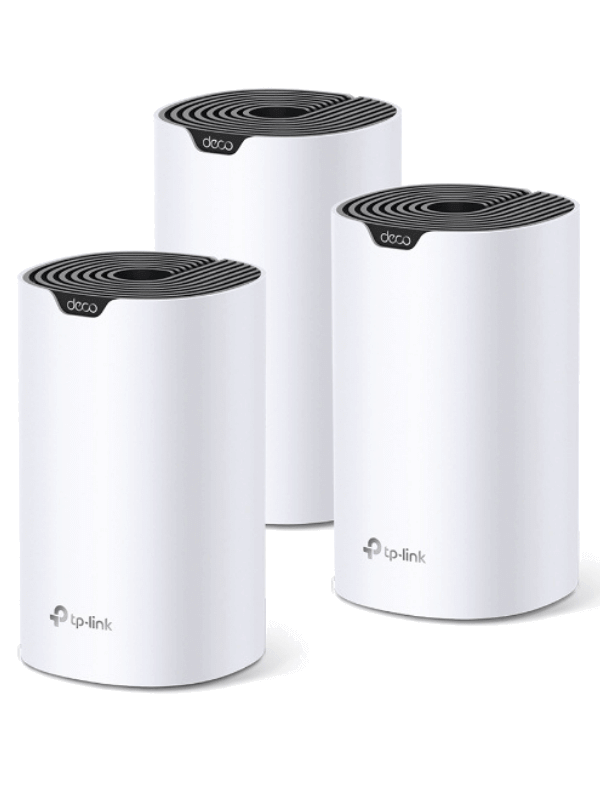
- Type: Mesh Wi-Fi
- Tested Max Speed: 317.27 Mbps
- Wireless Standard: Wi-Fi 5
- Recommended for: Internet 300 plan and below
- Warranty: 2 years
Pros
- Reasonable price
- Connects to plenty of devices
- Great range
Cons
- Not the fastest kit
You surely have noticed that router performance is significantly affected by distance. If you’re 25 or 50 feet away, like during our tests, you still get fairly usable speeds. But if you go much farther away, things get bad quickly.
So, if you have a large or multi-level home, distance can be a big problem. The best solution for this problem is mesh Wi-Fi systems. Which are a group of routers working together to create one large, seamless network.
If you are on a budget, the phrase “group of routers” might sound scary. That’s when the Deco S4 system comes to play.
For the price of a single router, the Deco S4 mesh system includes a router and two additional satellites that can cover a total area of over 5000 sq feet. Talk about value!
The Deco S4 came in at 317.27 Mbps during our tests at 5 feet in the 5 GHz band. Making it a great option for all but the fastest Mediacom plan (1000 Mbps).
Distance is not the Deco S4’s strong suit. At 25 feet away, we were only able to get 169.59 Mbps.
However, keep in mind that the whole point of a mesh system is that you will always be close to one of its satellites. If you’re not, time to add an additional satellite. The Deco S4 allows you to add as many as needed to your network.
Features are somewhat limited, but at this price point, we’re lucky they’re there.
Parental controls will allow you to filter URLs so devices can’t access them, as well as set browsing schedules and cut-off times.
QoS is included, but very basic. It will only allow you to prioritize one device over another. Not by activity or application. Also, no dynamic QoS.
Even with its limitations, the TP-Link Deco S4 is a banger deal. As long as you have the 300 Mbps plan or below, it’s a great option for large homes.
For more info, read our TP-Link Deco S4 review.
#7 Best Premium Mesh System – Orbi RBK852
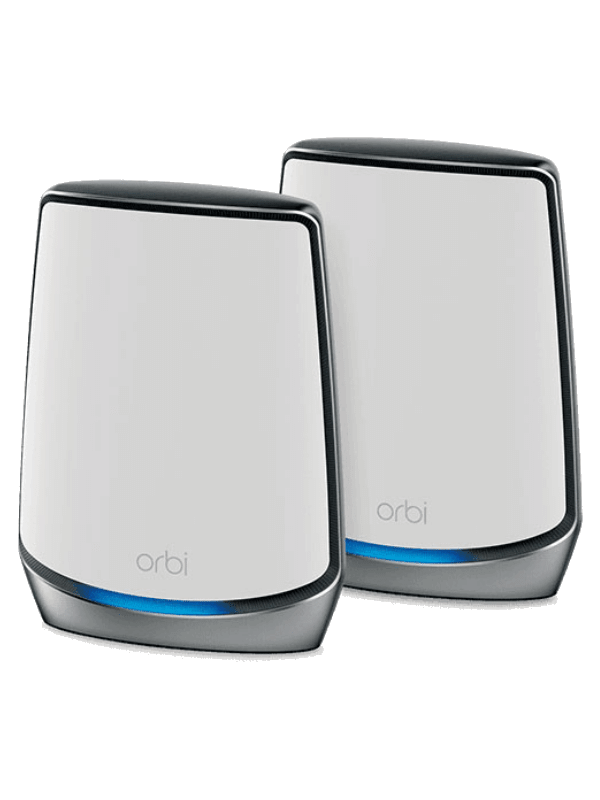
- Type: Mesh Wi-Fi
- Tested Max Speed: 851.86 Mbps
- Wireless Standard: Wi-Fi 6
- Recommended for: Internet 1000 Mbps plan
- Warranty: 2 years
Pros
- Super quick
- Great coverage
- Fast satellites
Cons
- Expensive
- No USB ports
If you have a large home and Mediacom’s Gigabit plan, things start to get expensive.
You’ll need a mesh system capable of handling such speeds. And the Orbi RBK852 is just that.
Clocking in 851.86 Mbps during our tests at 5 feet distance on the 5 GHz band, it came pretty close to some of our best-performing routers.
The Orbi RBK852 is built for those who want performance over everything else (and have a large area to cover). This system can easily handle 4K streaming, heavy gaming, and big downloads without breaking a sweat. Even for families of 4 to 6 people.
It offers beamforming and MU-MIMO for increased performance. So its satellites can communicate with several client devices simultaneously, as well as point its signal directly to them for added range.
But that’s as far as features go. No parental controls, no QoS, just fast speeds.
The Orbi RBK852 was clearly built for a specific type of user, it’s for those seeking performance above everything else.
If that happens to be you, no other mesh system will come close in terms of quality and reliability.
Honorable mention to another Orbi mesh system, the RBK752, which will give you around 90% of the RBK852’s performance for about half the price.
For more info, read our Netgear Orbi RBK852 review.
Mediacom Router Buying Guide
Mediacom Cable internet is available in 22 states across the US and provides service to around 6.5 million users. Making it the fifth-largest cable internet provider in the country. [1]
As usual, which Mediacom plans are available to you will depend on your location. However, Mediacom claims that 97% of its users can expect to have every plan available to them.
Mediacom is exclusively a cable internet provider, though they claim to be working on a direct-to-home fiber option.
Let’s see the main factors that you should consider when buying a new router, and how Mediacom performs on each.
Speed
Mediacom plans are exclusively cable internet (for now), and they offer 4 options. 60 Mbps, 100 Mbps, 300 Mbps, and 1000 Mbps (Gigabit). [2]
Whatever your plan is, you need to make sure your router is able to handle it. Otherwise, you’ll be overpaying for bandwidth you can’t use.
Conversely, no matter how fast your router is, it will always be limited by your internet plan’s max speed.
An important thing to note: Mediacom’s plans start at competitive prices, but they significantly increase after 12 months.
Even worse, prices increase yet again after 24 months. At this point, you will be paying almost double your original rate.
Wireless Standard
Since Mediacom’s plans range from a bit slow to blazing fast, wireless standards become important.
For plans of 300 Mbps or less, Wi-Fi 5 options are good and enough. As Wi-Fi 5 routers usually cap at around 600 Mbps.
For the Gigabit plan, however, you’ll want to make sure to use a Wi-Fi 6 router in order to take advantage of it.
Speeds are not the only consideration here. Wi-Fi 5 routers are usually much cheaper while offering comparable or identical features.
In summary, which wireless standard you choose should be based mostly on your internet plan’s speed.
For more info, check out our article on Wi-Fi 5 vs. Wi-Fi 6.
Bands
Besides the NETGEAR RAXE500, which is tri-band, all routers in this article are dual-band. This means they can use both the 2.4 GHz and 5 GHz frequencies (add 6 GHz for tri-band).
The 2.4 GHz band offers much longer ranges and a better overall signal. It’s capable of traveling through walls and obstacles much better than the others. However, max speeds in the 2.4 GHz can be underwhelming.
If you want to get into the 500-900s Mbps range, you’ll need to use the 5 GHz band. This band will be more affected by distance and obstacles but is able to output significantly better performance.
If you need even more than that, you’ll need to jump to the 6 GHz band and a compatible device. With this band, you’ll easily be able to break Gigabit speeds.
All of that being said, we recommend setting your router to “Auto” and letting it automatically choose which band to use depending on what you are doing and where you are located.
But if you want to go manual, make sure to be connected to 5 or 6 GHz if you have the Mediacom internet 300 plan or above. Otherwise, you’ll lose too much bandwidth with 2.4 GHz.
For more info, check out our article on dual-band vs. tri-band routers.
Mesh Wi-Fi
Most routers, even the best ones on the market, have a maximum range of around 110 feet. Beyond that, you’ll lose too much performance or lose the signal completely.
This is where mesh Wi-Fi systems come to place.
A mesh network is a group of interconnected access points working together to look like a single Wi-Fi signal that covers a much larger area.
As you move around your home, your devices will jump from one access point to another without you noticing anything. Ensuring you are always connected to the closest one for better performance.
This might sound attractive to everyone, even if your home is not too large. But keep in mind most mesh Wi-Fi systems are considerably more expensive than a stand-alone router.
How much you spend on a mesh system will greatly depend on your Mediacom internet plan. A budget one might be more than enough for the 100 Mbps plan, but useless for Gigabit.
For more info, check out our article on mesh Wi-Fi vs. traditional routers.
Features
Depending on who you ask, features might be even more important than performance at the time of buying a router.
If you have children, for example, parental controls become a necessity. A feature most premium routers seem to ignore.
Another feature that people consider crucial is Quality of Service (QoS) which helps you prioritize activities. For example, have you ever been in an important call that keeps dropping because someone else is downloading a large file? QoS helps you prevent situations like these.
Then we have things like guest networks, something even the most basic routers should include.
Guest networks, as the name implies, will create a completely separate network for people outside of your household to connect to. This helps you avoid them accessing your router’s admin settings, as well as preventing them from infecting your network or devices with malware.
Frequently Asked Questions
Here are some common questions regarding Mediacom and its equipment.
Do I need a modem for Mediacom?
Yes. You will need a DOCSIS 3.1 modem for any and all Mediacom plans. You can buy one of your own (which we suggest), or rent one directly from them for $12 a month. [3]
If you’d like to buy instead of rent, check out our Mediacom-approved modem list.
Do I need a router for Mediacom?
Also yes. In addition to the modem, whether your own or rented, you will need a wireless router in order to have Wi-Fi.
Once again, Mediacom will give you the option to rent one from them.
As above, we usually recommend you buy your own router both because it’s cheaper in the long run and to achieve better performance.
However, Mediacom’s router rental is pretty attractive. For $10 bucks a month, Mediacom will rent you an Eero Pro 6 mesh Wi-Fi router with an additional satellite.
You can add more satellites for $6/month a pop.
If you consider the full price of the Eero Pro 6 mesh system, it’s honestly a decent deal.
Does Mediacom have data caps?
Unfortunately, yes. All Mediacom internet plans have data caps. Here are the details: [4]
| Plan Speed | Data Cap |
| 60 Mbps | 200 GB |
| 100 Mbps | 1000 GB |
| 300 Mbps | 2000 GB |
| 1000 Mbps | 6000 GB |
Once you go over your data cap, Mediacom will charge you $10 for each additional 50 GB of data.
Wrap Up
Mediacom plans are exclusively cable internet-based. They range from 60 Mbps and go all the way up to Gigabit speeds.
What router will suit your situation best will depend on your plan speed and the size of your home.
It’s a good idea to buy your router with your internet plan in mind. Otherwise, you’ll be either overpaying for your router or wasting bandwidth every month.
But if you are looking for an easy choice that is sure to cover most of your needs no matter the plan and at a good price, the ASUS RT-AX3000 is a clear winner.
It’s capable of handling close to gigabit speeds, and even if you have a lower-tier plan, its price is low enough for that not to be a real problem.

